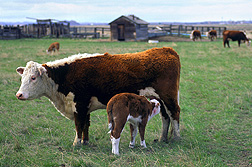This page has been archived and is being provided for reference purposes only. The page is no longer being updated, and therefore, links on the page may be invalid.
USDA'S Novel Cell Line Identifies All Foot-and-Mouth Virus Serotypes
By Sandra AvantMay 16, 2013
WASHINGTON, May 16, 2013—U.S. Department of Agriculture (USDA) scientists have developed a new cell line that rapidly and accurately detects foot-and-mouth disease virus (FMDV), which causes a highly contagious and economically devastating disease in cattle and other cloven-hoofed animals.
The cell line was created by Agricultural Research Service (ARS) scientists at the Plum Island Animal Disease Center, Orient Point, N.Y. ARS is USDA's chief intramural scientific research agency. The research, published online in the Journal of Clinical Microbiology, supports the USDA priority of promoting international food security.
"This important breakthrough is an example of how ARS scientists are working to improve agricultural productivity in the face of increasing demand for food," said ARS Administrator Edward B. Knipling. "This new cell line will help in the global effort to control a disease that can cause significant economic losses."
"The new cells detect the FMD virus in field samples that come directly from naturally infected animals faster than existing cell lines currently used for diagnostics," said Luis Rodriguez, research leader at Plum Island's Foreign Animal Disease Research Unit (FADRU). "The new cells are the first permanent cell line capable of identifying all seven serotypes of FMD virus."
The United States has not had an FMD outbreak in more than 80 years. However, the disease is still a serious threat and is considered to be the most economically devastating livestock disease worldwide. Outbreaks in other countries have resulted in the slaughter of millions of animals to prevent the disease from spreading.
Being able to rapidly detect the virus during outbreaks would allow researchers to quickly develop the appropriate vaccine among the seven serotypes and dozens of subtypes, thereby saving valuable time and millions of dollars.
The novel cell line stems from earlier research where FADRU scientist Hernando Duque isolated a primary cell receptor, called alpha v beta 6, which allows FMD virus to attach to and enter the animal's cells and replicate, Rodriguez said. Molecular biologist Michael LaRocco was a member of the team, led by former ARS scientist Barry Baxt, which created the new cell line.
The approach used to make the new cell line consisted of cloning the FMD receptor genes from bovine (cattle) tissue and incorporating them into a cell line previously established at Plum Island, and then comparing them to other cells currently used in diagnosing and studying FMD.
FADRU molecular biologist Peter Krug designed tests to validate the cell line by comparing it to other cell types using virus samples from animal tissues. The new cell line proved to be faster and more reliable than all current diagnostic cell lines in detecting virus in FMD-infected cattle and pig tissue samples from numerous countries.
"Other cell types currently used to diagnose FMD don't survive long and have to be obtained directly from animals as primary cell cultures, causing variation from one batch to the other," Rodriguez said. "This new cell line can be continually grown in culture, maintains susceptibility to FMDV much longer, and doesn't require getting new cells from animals repeatedly."
Scientists have applied for a patent on the new cell line and are making plans to distribute it to diagnostic laboratories in the United States and other countries.

